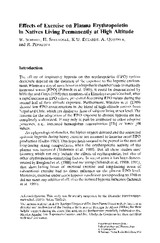Mostrar el registro sencillo del ítem
Effects of exercise on plasma erythropoietin in natives living permanently at high altitude
| dc.contributor.author | Schmidt, W | |
| dc.contributor.author | Spielvogel, H | |
| dc.contributor.author | Eckardt, KU | |
| dc.contributor.author | Quintela, A | |
| dc.contributor.author | Peñaloza, R | |
| dc.date.accessioned | 2017-09-20T13:39:38Z | |
| dc.date.available | 2017-09-20T13:39:38Z | |
| dc.date.issued | 1992 | |
| dc.identifier.uri | http://repositorio.umsa.bo/xmlui/handle/123456789/12488 | |
| dc.description.abstract | Abstract. The effects of inspiratory hypoxia on the erythropoietin (EPO) system decisively depend on the duration of the exposure to the hypoxic environment. Whereas a stay of some hours in a hypobaric chamber leads to markedly increased serum [EPO] (Eckardt et al. 1989), it could be demonstrated by Milledge and Cotes (1985) that members of a Himalaya expedition had, after a rapid increase in EPO values, presented decreasing EPO values during the second half of their altitude exposure. Furthermore, Winslow et al. (1989) showed low EPO concentrations in the blood of high-altitude natives from Nepal and Chile, which are similar to those of subjects living at sea level. The reasons for the adaptation of the EPO response to chronic hypoxia are not completely understood. It may only in part be attributed to other adaptive processes, e.g., increased hemoglobin concentration [Hb] or lower pH values. | es_ES |
| dc.language.iso | en | es_ES |
| dc.publisher | Springer Verlag | es_ES |
| dc.subject | PLASMA ERITROPOYETINA | es_ES |
| dc.subject | GRAN ALTURA | es_ES |
| dc.subject | NATIVOS DE GRAN ALTURA | es_ES |
| dc.subject | EPO | es_ES |
| dc.title | Effects of exercise on plasma erythropoietin in natives living permanently at high altitude | es_ES |
| dc.type | Book chapter | es_ES |

